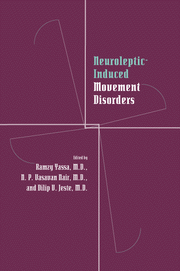Book contents
- Frontmatter
- Contents
- Contributors
- Preface
- Part I Historical perspective
- Part II Clinical aspects of tardive dyskinesia
- Part III Mechanisms underlying tardive dyskinesia
- Part IV Measurement of tardive dyskinesia
- 18 Instrument measurements of tardive dyskinesia
- Part V Tardive dyskinesia in different populations
- Part VI Other neuroleptic-induced movement disorders
- Part VII Treatment of tardive dyskinesia
- Index
18 - Instrument measurements of tardive dyskinesia
from Part IV - Measurement of tardive dyskinesia
Published online by Cambridge University Press: 09 October 2009
- Frontmatter
- Contents
- Contributors
- Preface
- Part I Historical perspective
- Part II Clinical aspects of tardive dyskinesia
- Part III Mechanisms underlying tardive dyskinesia
- Part IV Measurement of tardive dyskinesia
- 18 Instrument measurements of tardive dyskinesia
- Part V Tardive dyskinesia in different populations
- Part VI Other neuroleptic-induced movement disorders
- Part VII Treatment of tardive dyskinesia
- Index
Summary
The importance of a careful assessment of a patient with tardive dyskinesia cannot be overrated. Assessment of both the intensity and frequency of the disordered movements is necessary for a diagnosis of tardive dyskinesia. Measuring the severity of movements is important for documenting the course of the movement disorder and for evaluating the response to treatment, and sometimes even for prognosis. In fact, many clinical and medicolegal decisions are based solely on the findings in a thorough assessment. Unfortunately, reliable assessment of the severity of tardive dyskinesia presents a challenge. Gardos, Cole, and LaBrie (1977) noted that the absence of reliable, precise methods for assessment may be contributing to our inability to delineate the syndrome, to determine its prevalence, and to evaluate the efficacy of treatments; but the ability to monitor the severity and course of tardive dyskinesia is critical to our understanding and management of this disorder. A better understanding of the pathophysiology and pharmacology of tardive dyskinesia inevitably will depend on precise assessment of the distribution and variations of dyskinetic movements.
The earliest objective measurement for tremor was described in the literature more than 100 years ago (Peterson, 1889). Subsequent decades of research have produced several objective instrumentation approaches for assessment of parkinsonism (Evarts et al., 1979; Teravainen & Calne, 1980; Marsden & Schachter, 1981). Temporal and kinematic measurement of movements, measurements of frequency-domain spectral characteristics, and measurements of torque are now widely accepted approaches for assessment of bradykinesia, tremor, and rigidity, respectively.
- Type
- Chapter
- Information
- Neuroleptic-induced Movement DisordersA Comprehensive Survey, pp. 241 - 256Publisher: Cambridge University PressPrint publication year: 1996



